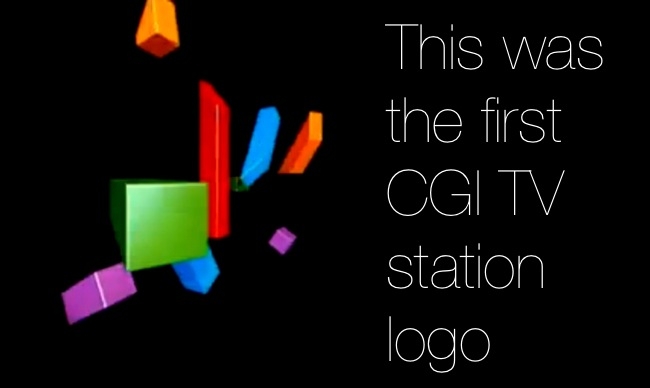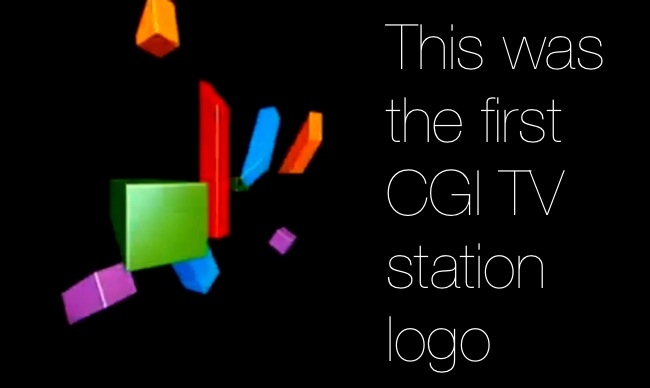
 Channel 4 animated logo 1982
Channel 4 animated logo 1982In the third instalment in our series looking at the development of VFX in films, Andy Stout looks at the rise of the computers and takes us from the basic (TRON) to the frankly sometimes terrifying (Jurassic Park)
In 1982, a new broadcaster, Channel 4, launched in the UK with a radical new ident. To the tune of four portentous notes, four coloured bars circled around each other until they formed the stylised 4 of the channel's new logo. The point of this story? This was one of the first mass market deployments of computer graphics anywhere on the world's screens and, to produce the image of the four coloured bars, the team had had to fly to Los Angeles to find powerful enough computers for the job.
No wonder that TRON (1982), the digital wonder of that year's cinema releases, only had 15 actual minutes of CG generated sequences throughout its entire length, mainly landscapes or vehicles and with a short, 'depth-cued' horizon that faded to black very quickly to save processing time. The 'Genesis Sequence' in Star Trek II: The Wrath of Khan (1982), however, beat it into the cinemas with a minute-long CG scene created by ILM that featured the first fractally-generated landscape and particle system committed to film.
Neither won the VFX Oscar that year, which instead went to E.T. the Extraterrestrial which had set aside a whopping 25% of its $10m budget for its practical effects work (including over $1m for the creation of E.T. itself). Meanwhile, Bladerunner (also 1982) with its futuristic urban nods towards Metropolis, was busy showcasing exactly how far digital techniques still had to go to become as convincing as the models used throughout the film. And Return of the Jedi (1983) broke the record for effects shots at the time, cramming 900 into its original 134min runtime and pushing optical compositing techniques to possibly their greatest achievements yet during the film's space battle sequences.
Slow progress with highlights
All of which perhaps helps to explain why the progress of digital techniques during the 1980s was perhaps slower than might have been imagined: they were expensive, still experimental and extremely time-consuming. When the first wholly CG photorealistic character appeared in 1985's Young Sherlock Holmes, a 30-second fight sequence involving a stained glass knight reportedly took over six months to produce.
All the same, the decade bequeathed some legendary effects work to the industry. Woody Allen's Zelig (1983) which inserted Allen's character convincingly into Depression-era newsreel footage, was a technical marvel of optical work and cinematographic genius; 2010 (1984) introduced computational fluid dynamics to the VFX toolkit with its recreation of Jupiter; Flight of the Navigator (1986) introduced reflection mapping to create the silvered skin of the alien craft; Labyrinth (1986) featured the first CG creature (an owl); Willow (1988) offered the first really convincing morphing sequences; The Abyss (1989) showed that CG water was possible; and Total Recall (1990) used motion capture for the first time to create its 'moving x-ray' sequence.
Putting digital on the map
Two films though at the start of the 1990s really put the seal on the ascendency of digital effects: James Cameron's Terminator 2: Judgement Day (1991) and Steven Spielberg's Jurassic Park (1993).
There was still plenty of traditional work in T2 - exquisitely filmed models were used for the opening battle sequences and the crashing truck at the end, air cannons blew apart models of Los Angeles and characters, and there was undoubtedly plenty of make-up - but it was ILM's work on Robert Patrick's T-1000 that really stood out. This was the first proper CG character since the knight in Young Sherlock Holmes and used reflection mapping and new morphing techniques that could convincingly map 2D images onto 3D animated objects to produce sequences such as the robot rising out of a checkered floor.
Jaw Dropper
It was all a bit of a jaw dropper but a mere two years later, impressive though those effects were, a combination of Steven Spielberg, ILM and Softimage knocked them into a cocked hat with Jurassic Park (1993). While the film used some incredibly complex animatronics from the ever spectacular Stan Winston Studios to achieve its effects - indeed, the majority of the dinosaur shots are practical ones - it was the CG dinosaurs that stole the show. Originally they were slated to be produced in go motion - a variant of stop motion which moves the models slightly during exposure to add motion blur - but the newly introduced inverse kinematics in Softimage 3D helped create such a realistic T-Rex walk demo that the production switched to CG for 50 of the dinosaur shots.
The likes of stop motion specialist Phil Tippet quickly found himself retraining and augmented the IK animation with his own DID (Dinosaur - subsequently simply Digital - Input Device) a traditional stop motion armature festooned with sensors that fed the animator's data direct to a wireframe skeleton. Once signed off, ILM artists then added muscle and skin, and set the whole thing moving to the awed and astonished delight of audiences round the world.
Just eleven years after TRON, the promise of CG had largely already been fulfilled. This was partly down to the stately progress of Moore's Law, partly down to the skill of a growing army of computer-based individuals, but it was also very much a period of transition in the VFX industry. Now it was time to see what the new breed of virtual vfx technicians could do.
Part 2 of The History Of VFX is here
Tags: Technology


Comments